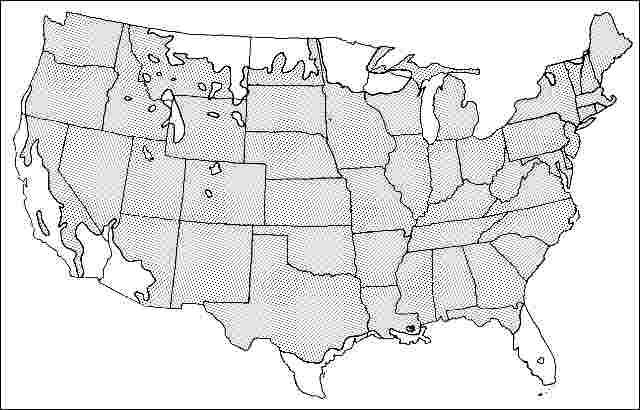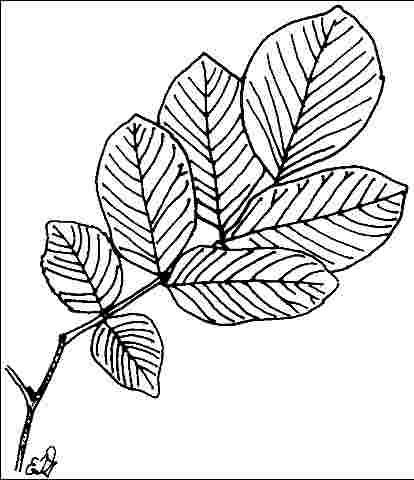Introduction
Yellowwood is so named because the freshly cut heartwood is a muted to brilliant yellow color, and the wood is known to yield a yellow dye. This seldom-used, native, deciduous tree makes a very striking specimen or shade tree, reaches 30 to 50 feet, rarely 75 feet in height, with a broad, rounded canopy and a vase-shaped, moderately dense silhouette. Smooth, grey to brown bark; bright green, pinnately compound, 8- to 12-inch-long leaflets; and a strikingly beautiful display of white, fragrant blossoms make yellowwood a wonderful choice for multiple landscape uses.

Credit: Ed Gilman, UF/IFAS
General Information
Scientific name: Cladrastis kentukea
Pronunciation: kluh-DRASS-tiss ken-TUCK-ee-uh
Common name(s): American yellowwood, virgilia
Family: Leguminosae
USDA hardiness zones: 4A through 8B (Fig. 2)
Origin: native to North America
Invasive potential: little invasive potential
Uses: specimen; shade; street without sidewalk; highway median
Availability: somewhat available, may have to go out of the region to find the tree

Description
Height: 30 to 50 feet
Spread: 40 to 50 feet
Crown uniformity: irregular
Crown shape: round, vase
Crown density: moderate
Growth rate: moderate
Texture: medium
Foliage
Leaf arrangement: alternate (Fig. 3)
Leaf type: odd-pinnately compound
Leaf margin: entire
Leaf shape: elliptic (oval), ovate
Leaf venation: brachidodrome, pinnate
Leaf type and persistence: deciduous
Leaf blade length: 2 to 4 inches
Leaf color: green
Fall color: copper, yellow
Fall characteristic: not showy

Flower
Flower color: white/cream/gray
Flower characteristics: very showy
Fruit
Fruit shape: elongated
Fruit length: 1 to 3 inches, 3 to 6 inches
Fruit covering: dry or hard
Fruit color: white/gray
Fruit characteristics: does not attract wildlife; showy; fruit/leaves not a litter problem
Trunk and Branches
Trunk/bark/branches: branches droop; showy; typically one trunk; thorns
Pruning requirement: needed for strong structure
Breakage: susceptible to breakage
Current year twig color: brown
Current year twig thickness: thin
Wood specific gravity: unknown
Culture
Light requirement: full sun, partial sun, or partial shade
Soil tolerances: clay; sand; loam; alkaline; acidic; occasionally wet; well-drained
Drought tolerance: moderate
Aerosol salt tolerance: unknown
Other
Roots: can form large surface roots
Winter interest: yes
Outstanding tree: no
Ozone sensitivity: unknown
Verticillium wilt susceptibility: susceptible
Pest resistance: free of serious pests and diseases
Use and Management
The 1-inch-wide, fragrant flowers appear in dense, showy, pendulous, terminal panicles, 12 to 14 inches long, in early summer, and are set off nicely against the lush foliage. Flowers are visited by a large number of bees. Trees may not flower until they are 10 years old and then seem to give outstanding displays only in cycles of every 2 to 5 years, but the gorgeous display is well worth the wait. The flowers are followed by showy, 3- to 4-inch-long, whitish-grey pods that persist through the winter.
Unpruned trees fall apart in 30 to 40 years. Yellowwood should be pruned when young to develop branches having a wide angle with the trunk and a U-shaped crotch. These should be pruned back so that they are not allowed to grow larger than half the diameter of the trunk. Develop 7 to 10 major lateral limbs spaced along the trunk, not clustered together. Good luck! This will help them develop strong attachments to the trunk and provide for a longer-lived tree than one that is not pruned in this way. Weakly attached branches with embedded bark are susceptible to breakage and may be a problem as the tree grows older. Any pruning should be done in summertime because excess bleeding may occur if done in the winter or spring. It could be used as street tree if properly pruned to avoid weak crotches. It is often planted as a specimen or shade tree for smaller properties due to its flowers and medium size.
Yellowwood grows slowly in full sun on moist, well-drained soils, but growth may be more rapid if provided with some shade in the southern part of its range and in the plains states. It grows slowly on poor soil but looks fine, responding to better soil with moderate growth. It tolerates alkaline (it is native to dry limestone outcroppings, as well as along stream banks) or acidic soil and urban conditions. It performs well with only occasional irrigation once established, even in poor, compacted soils. It adapts to wet soils by growing a shallow root system. There are several very large, coarsely branched roots dominating the root system, which makes care following transplanting very crucial. But planting from containers is no problem.
The cultivar 'Rosea' has pinkish flowers.
Propagation is by seed or cuttings.
Pests and Diseases
No pests or diseases are of major concern. Verticillium wilt may occasionally be a problem.